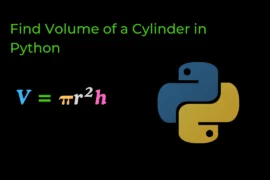In this post, you will learn the python program to multiply two matrices by taking input from the user but before writing a program let’s understand the rule for matrix multiplication and the algorithm to implement it.
Rules for Matrix multiplication
Let’s understand the rules for matrix multiplication with help of an example:
Suppose we have two matrices A of dimension mxn& B of dimension ixj |
Matrix multiplication of A & B is only possible if the number of columns in the first matrix is equal to the number of rows in the second matrix (n == i). |
And it gives a resultant matrix of dimension mxj. |
Example:

Algorithm for Matrix multiplication in Python
| 1. | Ask the user for the inputs of Rows & Columns of the matrix A and B. |
| 2. | if matrix_A_cols == matrix_B_rows: then |
| 3. | Create the matrix A & B by using the input() function and nested list comprehension. |
| 4. | For storing the result create another matrix (result) and initially, it is Zero. dimension of the resultant matrix is matrix_A_rows x matrix_B_cols |
| 5. | for calculation, we use 3 nested for-loop; 1st loop for rows (i) of the matrix, 2nd loop for columns (j) of the matrix, and 3rd loop (k) for calculation of resultant matrix that is: result[i][j] += matrix_A[i][k] * matrix_B[k][j] |
| 6. | At last print the resultant matrix (result). |
| 7. | else: print('Matrix multiplication is not possible') |
From the above algorithm, we understood how to implement the python program to multiply two matrices by taking input from the user.
But before writing a program few programming concepts you have to know:
Source code
# matrix multiplication in python
matrix_A_rows = int(input('ENter number of rows for matrix-A: '))
matrix_A_cols = int(input('ENter number of columns for matrix-A: '))
print() # for new line
matrix_B_rows = int(input('ENter number of rows for matrix-B: '))
matrix_B_cols = int(input('ENter number of columns for matrix-B: '))
print() # for new line
if matrix_A_cols == matrix_B_rows:
print('Enter values for matrix A')
matrix_A = [[int(input(f"column {j+1} -> ENter {i+1} element:")) for j in range(matrix_A_cols)] for i in range(matrix_A_rows) ]
print() # for new line
print('Enter values for matrix B ')
matrix_B = [[int(input(f"column {j+1} -> ENter {i+1} element:")) for j in range(matrix_B_cols)] for i in range(matrix_B_rows) ]
print() #for new line
print('Matrix-A :')
for i in matrix_A:
print(i)
print() #for new line
print('Matrix-B :')
for i in matrix_B:
print(i)
# mutiplication operation
# resultant matrix (matrix that store answer and intially it is Zero)
result = [[0 for j in range(matrix_B_cols)] for i in range(matrix_A_rows)]
# main logic for matrix multiplication (multiplication operation)
for i in range(len(matrix_A)):
for j in range(len(matrix_B[0])):
for k in range(len(matrix_B)):
result[i][j] += matrix_A[i][k] * matrix_B[k][j]
print() #for new line
print('Multiplication of Matrix-A and Matrix-B is :')
for i in result: #print result
print(i)
else:
print('Multiplication of matrices is not possible (columns of matrix-A = row of matrix-B)')
Output
ENter number of rows for matrix-A: 2
ENter number of columns for matrix-A: 3
ENter number of rows for matrix-B: 3
ENter number of columns for matrix-B: 2
Enter values for matrix A
column 1 -> ENter 1 element:1
column 2 -> ENter 1 element:2
column 3 -> ENter 1 element:3
column 1 -> ENter 2 element:4
column 2 -> ENter 2 element:5
column 3 -> ENter 2 element:6
Enter values for matrix B
column 1 -> ENter 1 element:10
column 2 -> ENter 1 element:11
column 1 -> ENter 2 element:20
column 2 -> ENter 2 element:21
column 1 -> ENter 3 element:30
column 2 -> ENter 3 element:31
Matrix-A :
[1, 2, 3]
[4, 5, 6]
Matrix-B :
[10, 11]
[20, 21]
[30, 31]
Multiplication of Matrix-A and Matrix-B is :
[140, 146]
[320, 335]





